Fungal infections, particularly in immunocompromised individuals, are responsible for nearly four million deaths annually—however, current treatments are limited and are frequently ineffective. Now, scientists at the Stowers Institute for Medical Research and the University of Georgia discover how the lethal pathogenic fungus, Cryptococcus neoformans, thrives, allowing them to identify potential novel therapeutic targets for treatment.

Published in PLoS BIOLOGY on June 5, 2025, the study refined a genetic tool to identify which genes in C. neoformans are essential for its survival. Importantly, the research team uncovered more than 1,400 required genes, including more than 300 that share no similarity with human genes, making them promising targets for new antifungal drugs with reduced risks for side effects.
READ MORE: Cannabis extracts show remarkable effectiveness against fungal pathogens
READ MORE: 119-million-year-old selfish genes discovered in yeast
“Cryptococcus neoformans kills around 150,000 people a year. It’s the AIDS-defining illness in the majority of HIV patients. Current treatments are limited, and outcomes are often poor,” said lead author Blake Billmyre, Ph.D., Assistant Professor at the University of Georgia and former postdoctoral researcher in the lab of Stowers Associate Investigator SaraH Zanders, Ph.D. “There is an urgent need to develop new therapies, and this study provides an atlas.”
Although humans and fungi bear little resemblance, genetically, we are surprisingly similar, which has historically made antifungal drug development difficult. Identifying essential genes in fungal pathogens that have no analog to human genes is critical for pinpointing potential antifungal agents that do not harm human cells.
Therapeutic targets
The team uncovered 302 ideal therapeutic targets in C. neoformans—however, because drug development is costly, the researchers also identified a subset of around 30 essential genes conserved across many pathogenic fungi, or 30 potential therapies that could destroy most fungal invaders.
“A big question in biology is which genes are essential for life as well as how they might change over evolutionary time,” said Zanders. “Blake’s TN-seq project opens the door to genome-wide screens for important traits in pathogenic fungi and will speed the pace of drug discovery.”
The team used a genetic technique called transposon mutagenesis sequencing, or TN-seq, where they damaged C. neoformans’ genome by bombarding millions of cells with small DNA segments called transposons.
“The analogy we use to explain TN-seq dates back to WWII,” said Billmyre. “Fighter planes returning to hangars were mapped for bullet damage to devise ways to strengthen them. However, areas of planes lacking damage were not necessarily better reinforced, but rather were never mapped because they never returned, a phenomenon called survivorship bias.”
Essential genes
Transposons landing within essential genes cause the fungal cells to die. By sequencing the DNA of the surviving cells, researchers can map which genes are vital for survival and which are not. Zanders explained: “The TN-seq approach mirrors this survivorship bias with transposon-ridden fungi. When we look genome-wide at all the places with and without damage, we can infer that if you damage a required region of the genome, the organism will die.”
TN-seq has been used widely in bacteria and in more established fungal species like baker’s yeast. This is the first time the approach was adapted for C. neoformans. It allowed the team to create a mutant library for C. neoformans—with millions of transposon-induced mutations including those in DNA that regulate essential genes. The researchers could then ask even more nuanced questions, such as which genes contribute not only to survival but also to resistance of antifungal drugs.
“Traditional methods involve deleting one gene at a time, but TN-seq lets us make deletions for the entire genome, allowing us to rapidly identify the repertoire of essential genes in Cryptococcus,” said Billmyre. “In addition, we were also able to use the tool to test both essential and non-essential genes that confer resistance to the most common antifungal, fluconazole.”
Temperature impact
Billmyre was recently awarded the prestigious NIH New Innovator Award to examine how fungi evolve to grow at high temperatures, which is key to understanding pathogenicity.
“My lab is now trying to understand the network of genes that enable fungal pathogens to grow at human body temperature,” said Billmyre. “This can inform us of what might happen in the future if increases in global temperature cause different species of fungi to acquire pathogenic properties.”







No comments yet